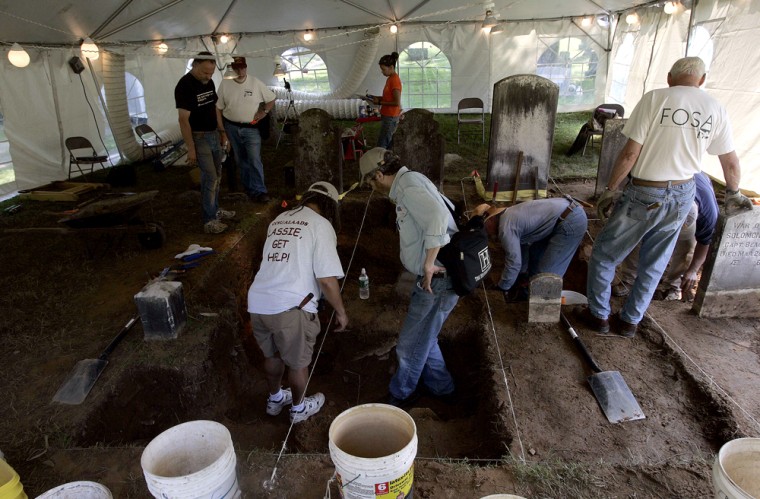Archaeologists excavating the 200-year-old graves of a slave family said Tuesday that they recovered several artifacts that could shed light on the life of a man dubbed “the black Paul Bunyan.”
However, the scientists uncovered no genetic material from Venture Smith, who is depicted in tales as a 6-foot-1 (185-centimeter) lumberjack slave whose fabulous feats of strength helped win his freedom. They had hoped to find DNA that would trace Smith’s life back to Africa, filling in the gaps of one of the earliest and most important slave biographies.
“We didn’t get much,” Nicholas F. Bellantoni, Connecticut’s state archaeologist, said about Smith’s grave. “Everything had been decomposed.”
But teams found several items from the nearby graves of Smith’s family that should help answer many questions, said Chandler Saint, president of the Beecher House Center for the Study of Equal Rights in Torrington, who is managing the excavation.
Remains were found in the other graves, though three to six months of testing will he needed to determine whether any DNA has been recovered, Saint said. Many artifacts were also found, he said.
“It’s going to be possible to determine a time of death, causes of death, from bacterial deposits in the soil,” Saint said.
He also said scientists will be able to determine the sizes of the family members from coffin dimensions and patterns.
“I’m really happy with what the various teams found,” Saint said.
Split seven cords a day
Weighing more than 300 pounds according to local lore, Smith is said to have split seven cords of wood each day. His biography describes him carrying a barrel of molasses on his shoulders for two miles and hauling hundreds of pounds of salt.

The biography, published in 1798, says his owner allowed him to work side jobs until he saved enough money to buy his freedom.
But slave biographies — particularly those told to writers, as Smith’s story was — were sometimes embellished, and family members hoped the excavation would reveal evidence that the man was as tall, healthy and strong as believed.
Bellantoni said the tales just might be true, based on a look at Smith’s coffin.
“It’s almost 7 feet (2.1 meters) long, very wide and very deep,” he said. “It’s also not a poor man’s coffin. It’s a very nice coffin for the period.”
The coffin was not removed, but scientists will study nail fragments and wood attached to them.
Though the dig had the support of more than a dozen descendants, environmental activist Nancy Burton challenged it in court, saying it was disrespectful to a state hero. In a compromise Tuesday, a judge ordered digging to stop at Smith’s grave but allowed it to continue at the nearby graves of his wife, son and granddaughter, Bellantoni said.
He said work on Smith’s grave was already complete. He expected excavation of the other graves to wrap up Wednesday.
